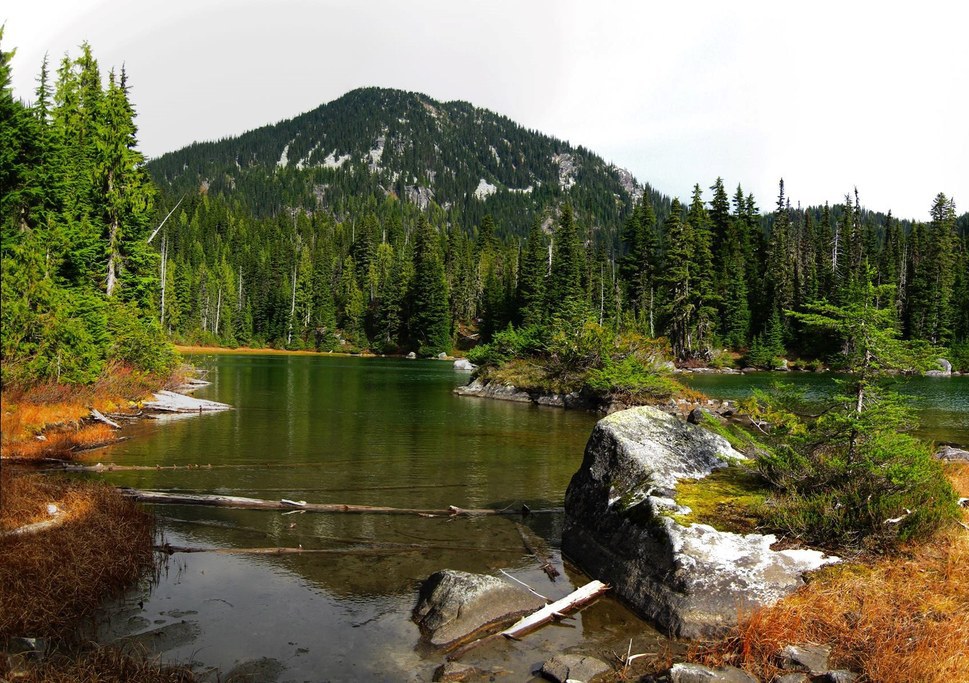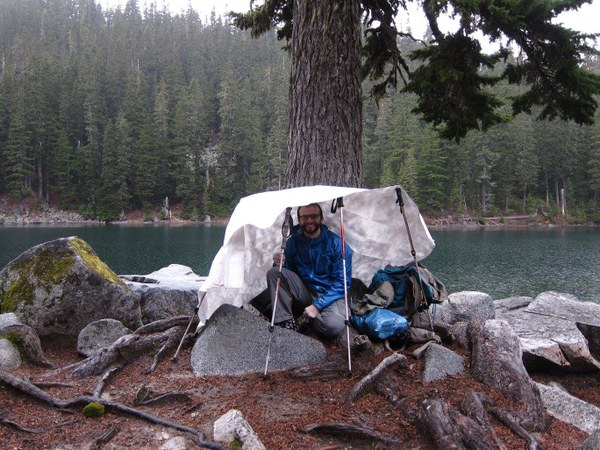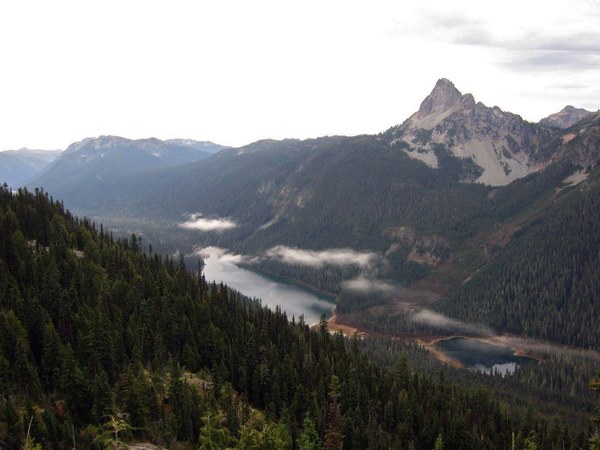
When my fiancé Chelsea and I moved to Seattle, we were thrilled to enjoy the amazing hiking and backpacking opportunities the Pacific Northwest has to offer. We decided to explore the Alpine Lakes Wilderness, having purchased the map shortly after moving. Our plan was to start near Stevens Pass, ascend along Surprise Creek, then join up with the Pacific Crest Trail to Deception Pass. We would then head up to either Marmot or Jade Lakes to camp.
It was a reasonably ambitious itinerary of 15.5 miles and 6,000 feet of elevation. Chelsea was a bit concerned about this, but I was not. We were experienced backpackers, having hiked the John Muir Trail (210 miles, 46,000 feet up, 38,000 feet down) and completing other similar trips in the past.
Typical for us, we arrived to the trailhead later than expected at 9:45am. We had a leisurely lunch at Surprise Lake, rigging up a makeshift shelter out of our ground cloth to escape the drizzle. After that excursion we stopped for photos at Deception Lake before continuing on to Deception Pass.

We soon realized that the sun was beginning to fade. I looked up, deluding myself that a cloud had passed over. It hadn’t. The sun was setting. We were not going to make the 3.5 miles and 1,600 feet up to Marmot Lake before nightfall. We contemplated returning to Deception Creek, where there were nice campsites. But it’s the Alpine Lakes Wilderness - why would we go so far only to not camp at an alpine lake?
We consulted the map and decided to divert to Tuck Lake only 1.5 miles away. It was 5:30pm, and sunset was just an hour later. We figured we could make it to the lake without issue. At worst, we would set up the tent by headlamp. We started climbing up the ridiculously steep trail, pulling out our headlamps as the last vestiges of daylight left.
My headlamp seemed dimmer than usual - I figured I had it on the wrong setting, pushing and holding the button, switching the batteries in and out. No luck. Within two minutes it had gone out entirely, leaving only Chelsea’s headlamp to guide us. After five minutes, hers began to fade as well. It became very apparent that we were about to continue our trek in the dark, unaided by our backup light sources.
At that point, we had to make a decision: descend down to the pass to find a spot to camp (in the dark on a steep trail), or continue climbing in the hope that there was a campsite somewhere up there. We decided on the latter, and continued along the trail.
We climbed up, intermittently turning on Chelsea's headlamp when it became too dark to see. It wasn’t long before the battery gave out entirely, resulting in my cellphone becoming our makeshift flashlight. The phone was old and the battery unreliable - I was praying it would hold up.
I became increasingly nervous we would have to camp on the side of the hill. It was so steep that I doubted we could even pitch a tent, and we’d have to sleep underneath our ground cloth. I started running through the possibilities. It would almost certainly rain. We would get soaked and develop hypothermia. There would be nowhere to hang our food, so we’d have to leave it on the ground and a bear would try to eat us in the middle of the night. We would fend it off, but suddenly it would start snowing. They would find our corpses when the snow melted out in the spring. We’d end up footnotes in a chapter of the soon-to-be-written Accidents in North American Backpacking.
Fortunately the trail began to flatten out, though we still couldn’t see much beyond the ground. We located a flat place to pitch our tent, cooking and eating dinner by cellphone light. I somehow managed to hang our food. We went to sleep.
When we woke up, I walked outside and saw two things. The first was Tuck Lake, 100 feet away. The second was a toilet seat lying on the ground a few feet from our tent. We had pitched our tent next to what appeared to be an abandoned privy. There is an obvious pun about the location of the tent site relative to the privy, but I’ll leave that to the reader’s imagination.
We decided to forgo a trip down to Marmot Lake, mostly out of spite. On the way down we enjoyed a beautiful view of Mt. Daniels and Hyas Lake, before finally making it back to the car without incident.

Lessons Learned
We made a bunch of mistakes, but ultimately if our headlamps had held up things would have been manageable and not particularly stressful. With that said:
- Check the batteries on your headlamp before you go. I had turned them on at home to make sure that they still worked, but never bothered actually checking them with a battery tester to ensure they had enough juice to last.
- Don’t use low quality batteries. We were using cheap dollar store batteries from the fake lanterns and candles in our wedding. We probably should have used higher quality or even lithium batteries.
- Set an itinerary. We should have set a time by which we were due to arrive at Deception Pass. Once it became clear that we were way behind schedule we should have made the decision to divert course.
- Consider sunset time. I vaguely knew that the sun would set early, but didn’t realize just how early 6pm is on the trail. 16 miles at 2.5 miles per hour means we would have arrived just before 5pm, if we hiked continuously and didn’t stop to enjoy the scenery. That’s a very tight timeline, which we should’ve made note of before departing.
- Know your terrain. This was my first backpacking trip in the Cascades aside from the Wonderland Trail. I assumed that doing 16 miles would be relatively straightforward as we had done that innumerable times before, but the terrain was more rugged than I anticipated.
- CalTopo is your friend. I planned using the Trails Illustrated map, which is a very nice map, but CalTopo gives you additional information like the total elevation gains and losses and a profile of your trip. If I had looked at that, I probably would have altered the trip.
- Arrive to the trailhead on time. (Just kidding - that will never happen outside of a Mountaineers trip!)
Add a comment
Log in to add comments.A grand and resourceful tale. Suggestion: Buy a block of batteries. Test headlamp(s) night before in a dark(ish) room. Refresh, as needed. Buy a second headlamp. Take both. Confession: My headlamp failed the first of 40+ city night hikes I led a couple of years ago.
 Adam Greenbaum
Adam Greenbaum